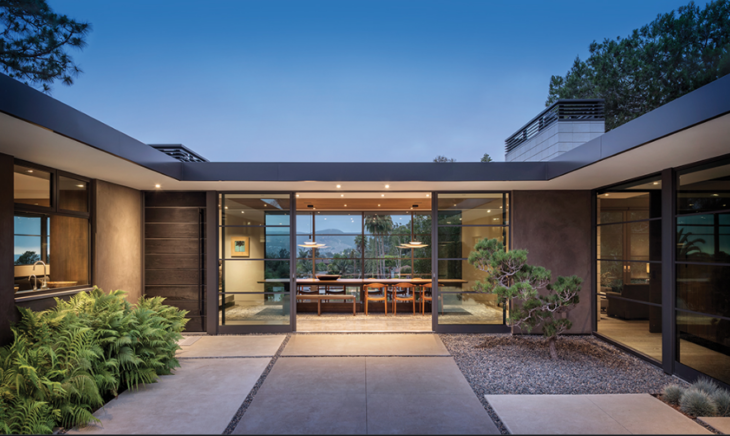
Scott Alexander has a long post discussing why we build modern buildings that are ugly, rather than the sort of beautiful older buildings that were constructed in previous centuries. Tyler Cowen laments the fact that modern American residential neighborhoods are much less attractive than older residential neighborhoods.
At first glance, the two pieces might seem similar. But Cowen actually likes the sort of edgy modern architecture that Alexander dislikes. Here I’ll argue that Alexander is mixing up a bunch of issues that seem related, but are actually quite distinct.
Here are my claims:
1. Modern architecture can best be understood by considering three categories: single family home, mid-sized non-profit, and corporate buildings (including skyscrapers and Apple stores.) The mid-sized non-profit sector is where you see most of the “ugly” architecture that people dislike. As with all other art forms, the best architects have advanced to the point where average people can no longer appreciate their creations. It’s no different in serious novels, painting, classical music, poetry, art films, etc. There are a few “ugly” modern houses and “ugly” modern skyscrapers, but most individual people and for-profit corporations won’t pay for what they view as ugly. Edgy architects need the non-profits.
2. New residential construction in conservative towns is uglier than new construction in more liberal towns. Liberal Laguna Beach has nicer new construction than conservative Newport Beach. The difference is large, and is unrelated to whether the new houses are contemporary or traditional. This claim is based on hundreds of hours of observations. When I travel, my favorite activity is walking through random residential neighborhoods, looking at houses. Today, you can easily verify my claim using Zillow. Here is a modern home in Laguna Beach:

3. Most new houses in the modern style are more attractive than most new houses built in traditional styles. Modern architecture is not being foisted on the public. Rich people who build a new home along the ocean in La Jolla or Laguna Beach or Malibu have enough money to build an English Tudor, or a Georgian or a Gothic style house, but they usually prefer a modern design. It looks better. The best looking houses in Palm Springs are mid-century modern:
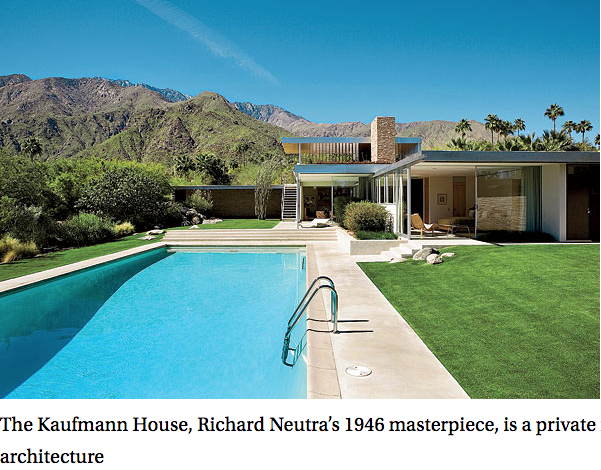
4. I’m going to sound like an insufferable snob, but richer people have better taste, on average. The fact that new $3 million homes are more attractive than new $600,000 homes is partly about the budget, but not entirely. Ugly $600,000 McMansions contain lots of awkward features like misplaced Palladian windows that actually add to the cost. It’s not all about the budget. America’s spectacular economic success has created a vast number of semi-rich people with bad taste. (Which is good!)
5. Alexander mixes up several unrelated issues in comparing modern architecture with older styles, such as buildings with and without lots of ornament, and edgy vs. graceful. Graceful modern buildings differ from edgy modern buildings in a way that has nothing to do with a lack of ornamental features such as intricate stone carving. There are lots of ugly older buildings that are full of ornament, and there are lots of beautiful modern buildings with a sort of classical simplicity. (And of course vice versa is true.)
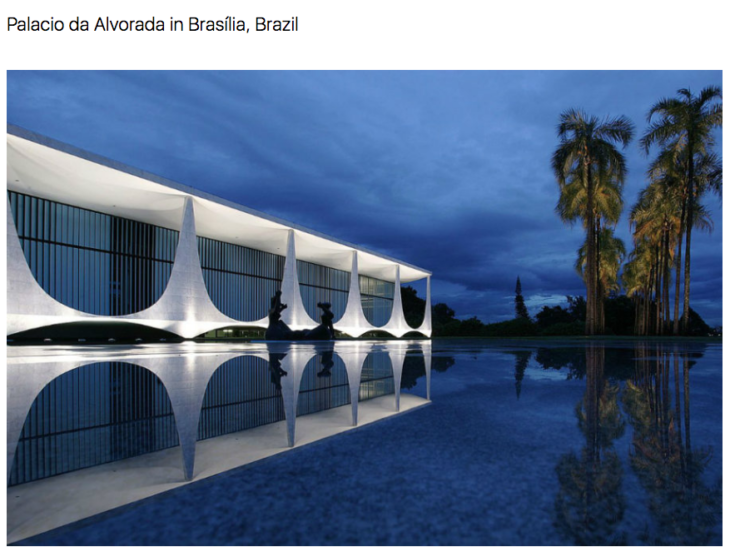
Mies van der Rohe’s Seagram building:
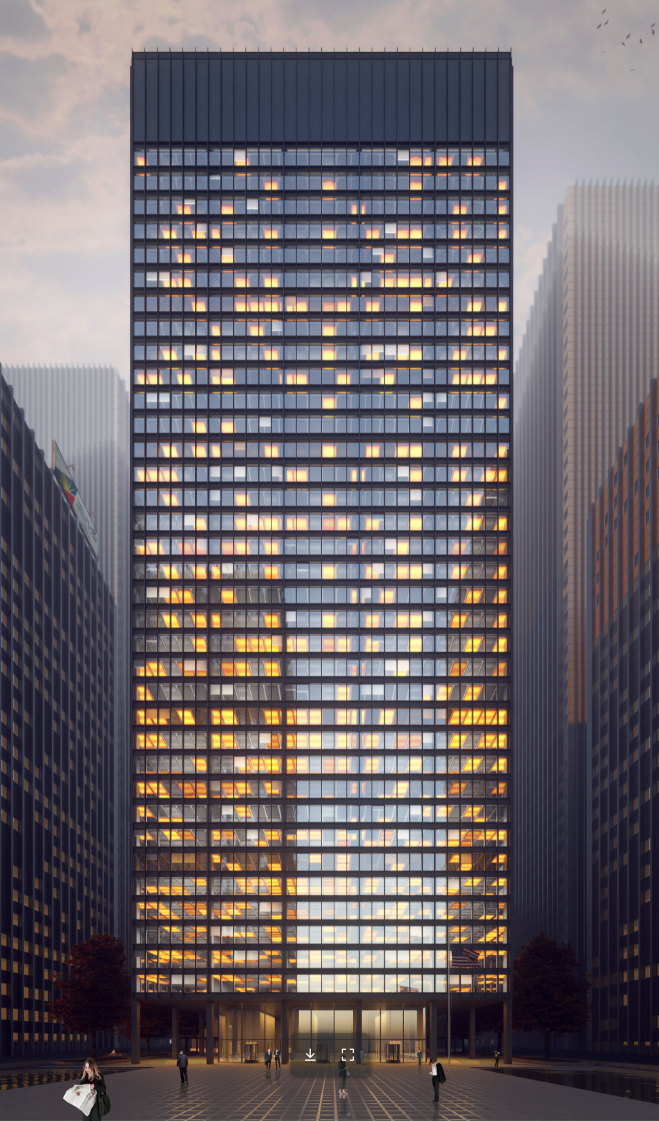
6. Skyscrapers are a sort of special case. Because of their scale, traditional styles don’t generally work very well. Chicago’s (gothic) Tribune Tower is fine, but China tried to build skyscrapers topped with traditional Chinese motifs and they were almost universally ugly. Art deco is a transitional style between traditional and modern. New York’s great art deco skyscrapers are beautiful, but today people want bigger windows. Would another Chrysler building plunked down in Miami have been better than Hadid’s new (post-modern) tower?
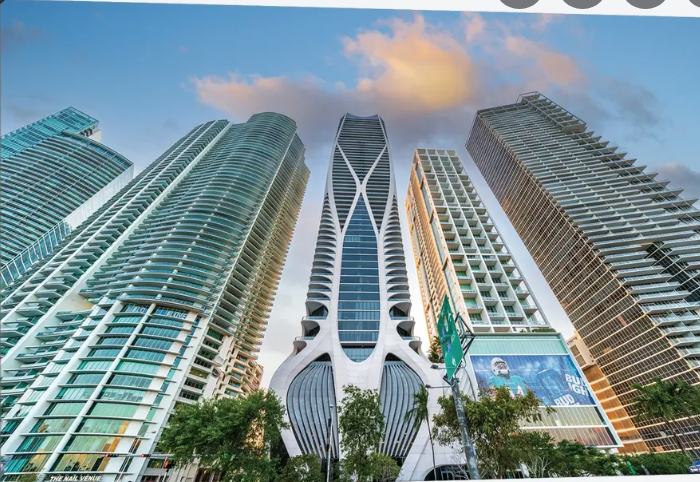
What else are Miami architects supposed to build? (The little art deco hotels in Miami Beach are wonderful, but do they scale?)
7. The elite vs. masses framing is not useful, as there are actually three important groups; the elite, the educated, and the uninterested. I’ll use an analogy from painting to illustrate my point. Let’s say that 1% of the public appreciates the paintings of de Kooning. Assume 10% like Van Gogh (that’s 33 million Americans). And assume that 90% don’t care enough about painting to even visit an art museum. What then? Which art is “popular”?
If you show everyone in the world a pretty painting by Bouguereau and a self-portrait of Van Gogh, most people will say the Bouguereau is better. But if you bring a Van Gogh exhibit to your local art museum, then 10 times as many people will show up as to an exhibit of Bouguereau. So which artist is “more popular”? That’s not even a question, as there is no clear definition of “popular”. Popular with everyone, or popular with people who look at paintings?
As an art form progresses, it gets more and more difficult for average people to appreciate the art works. That’s not a problem for painting, which the public can easily ignore. It is a problem for the Boston City Hall, which Tyler Cowen can appreciate but most people cannot. It’s in your face. It’s not one of the graceful “classical” examples of modernism.
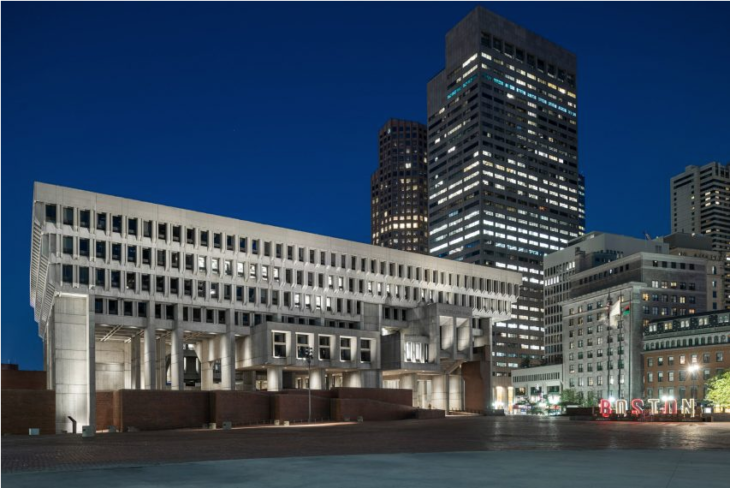
To my eyes, brutalist architecture is more difficult that post-impressionism, but not as difficult as de Kooning. Maybe roughly as difficult as Jackson Pollack or Mark Rothko. Not a lot of individuals or corporations will choose difficult architecture, but a few will. Most often, it’s non-profits that go for this stuff, as with MIT’s decision to hire Frank Gehry to do one of their buildings:
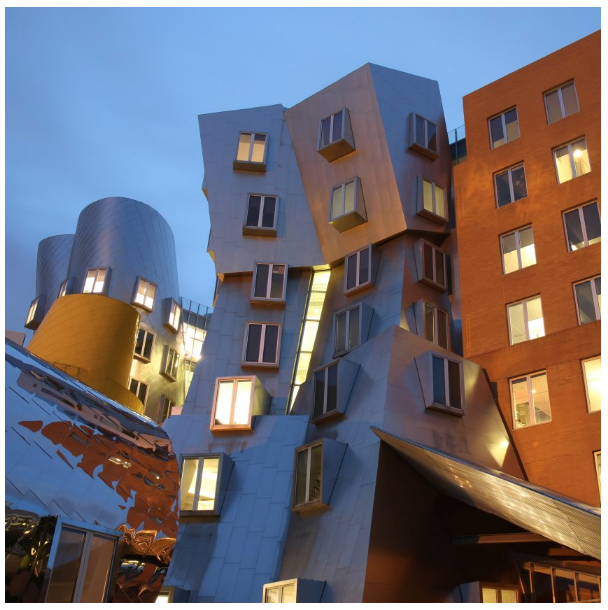
To summarize, people struggle with this issue because they don’t realize that it’s actually multiple issues. For skyscrapers, the international style is the only thing that really meets our modern needs. When it comes to residential houses, it’s simply wrong to suggest that modern architecture is ugly. Modern style houses being built today are quite attractive, and the ugly houses being built today are mostly McMansions that try but fail to ape traditional styles of architecture. Some good traditional-styled houses are being built, mostly in liberal areas. Mid-sized buildings put up by non-profits are what most people visualize they think about “ugly” modern architecture. Some of this is in fact ugly, whereas in other cases it’s just difficult art that goes over the head of most people. Sometimes over my head. Time will tell.
I don’t entirely disagree with Alexander. Indeed, I actually have rather conservative taste in art, which might surprise readers of this post. I prefer Richardson, Sullivan and Wright to Gehry and Koolhaas. I often prefer older buildings. And I even like homes like the one below, which looks like 16th century Tuscany, but is actually 21st century Irvine, CA.
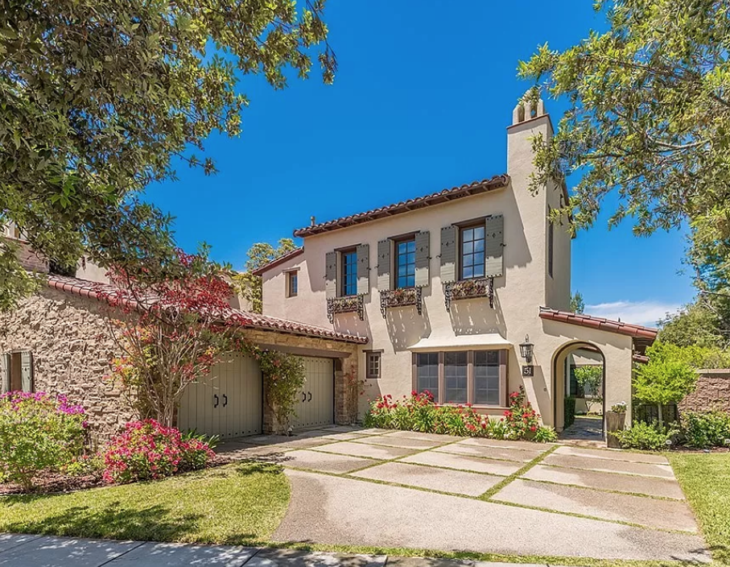
I just think it’s more complicated than simply old architecture is good and new architecture is bad.
PS. Here’s another example of how Alexander’s framing doesn’t work. We are told that modern music is ugly for most listeners. Not like the greats of the past. OK, would the average person prefer to listen to a composition by someone like John Williams or Andrew Lloyd Webber, or would they prefer to listen to one of Beethoven’s last three piano sonatas?
The problem with modernism is not necessarily what you think it is.
PPS. To head off accusations of hypocrisy, I do live in a modern style home, but previously lived in a traditional style home. I just want my home to be attractive and useful.

READER COMMENTS
michael thomas
Oct 5 2021 at 8:11pm
I haven’t read the Alexander or Cowen articles. But isn’t one obvious point to make about Cowen’s observation – i.e., modern neighborhoods are less attractive than older neighborhoods – that older neighborhoods that exist today were preserved precisely becuase they were so charming, and that the less-charming old neighborhoods were removed and replaced? So it’s an unfair comparison because time has edited the stuff that wasn’t worth keeping out.
It’s similar to the “why are old buildings so much better constructed than new buildings” comment – I mean, one answer is becuase the poorly built buildings don’t last 400 years, right?
The same point could be made about art and literature, etc.
As a separate point, the truth is that most homes aren’t designed well at all. It seems like most architects are actually quite incompetent (and have been quite incompetent for many years) both at making a beautiful building, and also at making a useful, liveable, well-designed building.
john hare
Oct 6 2021 at 4:51am
I have noticed this in the building trades that much of the architecture is either poorly thought out or cut and paste of things done a thousand times. I remember the first hour in a construction working drawings class forty mumble years ago the prof laying out some basic principles. Principles that most seem to have never grasped. I strongly emphasize with the last sentence in the PPS— I just want my home to be attractive and useful.
Phil H
Oct 6 2021 at 4:58am
“most architects are actually quite incompetent”
We recently bought a property (in Xiamen, south China). Now, what we bought is a concrete shell in a highrise building, so no architect was required as such, but we were free to play with the interior divisions and fit it out however we want, so it was quite a large job. We went to a number of design firms to get quotes and ideas. The level of incompetence was remarkable! Like all Chinese cities, Xiamen is growing very fast, so I imagined there would be quite a lot of competent designers around, but I was very wrong. I think 5/6 of the people we saw simply cut and pasted, as John O’H said above. The one that didn’t gave us a genuinely good design, which we like, but was then completely uninterested in the little adjustments that needed to be made to make his “statement design” livable.
Phil H
Oct 6 2021 at 5:00am
Sorry, John Hare, I got your name wrong in this post. Incompetent posting on the internet!
Scott Sumner
Oct 6 2021 at 12:09pm
China is an interesting case. Over the past 30 years, construction quality has gone from horrible to mediocre. It’s important to recall have fast China has developed. Their (physical) economy has grown faster than their human capital, and thus to Western eyes they often seem incompetent.
Max S
Oct 7 2021 at 4:09pm
Tyler Cowen makes this point in his article, although he may not assign it the weight you feel it deserves. From the article:
““Selection effects” are also often cited as an explanation for the decline of neighborhood beauty: The best neighborhoods from the past are (at least partially) preserved, conveying an overly glorified sense of the aesthetics of previous eras. It’s a good point, but it’s hard for me to name many recent neighborhoods that will go down in history as aesthetically admirable.”
Mark Z
Oct 5 2021 at 8:31pm
I’m surprised at your lack of pushback against (other) Scott’s skepticism of economic explanations (from what I gather; I only cursorily perused his post), which I think he underplays. The cost of stonemasonry and goldsmithing have gone up enormously relative to modern building styles. For that reason I don’t think you can look at new houses as indicative of taste, bur rather rather the relative value of existing old vs. new buildings, ceteris paribus. I think his counterexamples re labor costs actually reinforce this point: it’s become much cheaper to mass produce art, statues, and clothes without the attention to detail required by pre-modern means. Relatedly, the fact that we can produce representationalist art perfectly now with technology pushes modern artists toward greater degrees of abstraction, since a painter can’t compete with a camera on realism. I don’t think that’s necessarily progress though.
I disagree with your rather objectivist take on art in any case. I posit a couple alternative hypotheses: 1) modern abundance allows for unprecedented tailoring of art to niche audiences in a way not economically or technologically feasible in older times; or 2) esotericism is valued for its own sake (thinking of the stereotypical hipster who only listens to obscure bands which he abandons once they’re no longer obscure) especially among those who identify as belonging to a rarefied elite (which probably correlates at least to some extent with actually belong to such a rarefied elite). How would you prove your thesis correct and those two wrong? Maybe in some cases, like certain genres of music, one can measure complexity and comprehension thereof, but not sure about architecture. I don’t believe Frank Gehry is beyond anyone’s comprehension.
Scott Sumner
Oct 6 2021 at 12:14pm
I don’t believe that pre-1840 artists were trying to do what cameras do. Do you think paintings by El Greco or Turner were attempts at photorealism?
I reject your second point because I actually like lots of art that others view as boring, such as very slow foreign films. So why should I assume others are faking it?
Kaleberg
Oct 7 2021 at 11:31pm
Most pre-1840 artists were exactly trying to do what cameras do. They were trying to make visual records of the appearance of people, places, buildings, scenes and so on. There were a handful that were trying to do other things, but the bulk were producing portraits of people and favored animals, house and grounds paintings, scenic paintings, paintings of religious themes, government events and the stuff people still take snapshots of.
The goal was not photorealism. It was photography, capture and impression. Think of El Greco as being extra creative with Instagram filters.
Bob
Oct 8 2021 at 12:34am
They were trying to be realistic, mostly, in some ways, but a whole lot of paintings in the era are really trying to capture an idealized essence of someone, just like hand painted portraits you can order today. So even the most photorealistic artist was really also trying to add the greatest of instagram filters.
The staging was also very different from the real world: All those equestrian paintings aren’t really about depicting real poses. Napoleon’s horse wasn’t rearing like that, and there’s no way in hell that Velazquez was trying to depict a real, practical snapshot in Las Meninas. El Greco definitely was going way past the instagram filter: The proportions were wrong on purpose. I bet that Goya’s 3 of May is not trying to be all that realistic, and that’s before getting anywhere near his dark period. And that’s a painting where he absolutely was trying to depict a historical event!
So while classical masters had far more interest in representing things that resemble reality than many artists from the 20th century and beyond, getting past photorealism is all over history: It’s just that to sell those expensive paintings that were past the norm, you either had to be like Goya, and have some outrageously good patron, or be just that good as to be able to get past photorealism and still sell the painting. If anything, it’s the availability of cameras that pushed painters away and made them just have to embrace experimentation, instead of having to be just extremely good to have any success.
Scott Sumner
Oct 9 2021 at 1:57pm
“Most pre-1840 artists were exactly trying to do what cameras do.”
That’s just wrong. They were doing far more than depicting reality. Modern art would have happened with or without cameras, and was already beginning to happen before cameras.
Ken P
Oct 5 2021 at 9:24pm
Great examples, Scott. The Tuscan isn’t very appealing to my tastes but I don’t see it as aesthetically unpleasing either. I actually like the brutalist building but I’m most impressed with the person that secured the building permits. The Seagram building is a bit plain until you scroll down enough to get a sense of scale. The Hadid building is very impressive, but my favorite on here would have to be the Kaufmann House. The contrast of the simple lines contrasting with the organic mountains is great and that second floor has to have an amazing 360 view.
Dan
Oct 5 2021 at 11:36pm
I think there is a data problem here on the old architecture. I would bet that much of what we call old architecture that survives is the good stuff. The bad old stuff has already been torn down, so we don’t see it anymore.
murmur
Oct 6 2021 at 3:19am
Even though they have enough money to build classical style houses, they’re not allowed to because of zoning laws. New buildings have to conform to the prevailing style to get approval from the planning commissions. So modern architecture is definitely being foisted on the public.
Tim
Oct 6 2021 at 12:03pm
This is true for commercial and multifamily buildings but false with respect to single-family homes. Vanishingly few communities impose architectural design standards on single-family construction–a house will need to meet things like setback and yard requirements, building code, etc. but these codes are typically silent with respect to architectural style and won’t even go before a planning commission.
Bob
Oct 8 2021 at 12:39am
The zoning code itself will say little of architectural styles, but when most houses are built as a 30+ house subdivision, all at once, and said subdivision happens to come with an HOA, and possibly a local architectural review board for any future changes, there are many situations where you really get to build what they let you, if anything at all.
If you happen to be able to live in a place without an HOA, or an architectural review board, good for you! Around here, the ability to do that in R1 zones tends to be limited to areas where your lot sizes are so outrageous the house won’t be visible from the road anyway. Hell, changing a deck into a stone patio in your backyard might require architectural review!
Eric
Oct 14 2021 at 2:39pm
At least here in Seattle, that’s wrong. If you want to rebuild a house (which is pretty much the only option in the inner suburbs where I live), you *will* have to have your design approved, and as a result, all the new construction looks exactly the same (namely, a bunch of lego bricks). Multifamily construction is even worse; the planning commission hates cars, and expects developers to build 36 unit apartment complexes with 6 parking spots.
Scott Sumner
Oct 6 2021 at 12:15pm
I don’t believe there are many zoning rules that mandate modernist designs.
Scott Sumner
Oct 6 2021 at 12:20pm
BTW, right next door to my modernist house in Orange County is an English Tudor.
Kaleberg
Oct 7 2021 at 11:35pm
If you head up to Bel Air, you’ll get a great sense of what rich people like, and they each seem to want something different, so you get an oversized Tudor next to a Greek temple not far from a pagoda next to a modern cube beside a crenelated castle. A friend of mine lived up in a tony Westchester county neighborhood like that. His father’s house was pretty conventional, though huge, but a morning jog was like browsing an architecture of the world travelogue.
murmur
Oct 6 2021 at 3:23am
This is your personal taste to which many will disagree. I like the Newport Beach houses far more than Laguna Beach Houses.
Scott Sumner
Oct 6 2021 at 12:16pm
Are you a conservative?
Aladin
Oct 7 2021 at 2:45pm
Is there a causal mechanism here other than claiming conservatives have poor taste?
Colin C
Oct 7 2021 at 9:47pm
There’s a fairly well-known correlation between conservatism and the personality trait openness. High openness corresponds with novelty-seeking and enjoyment of more out-there forms of art, while low openness corresponds with preference for routine and enjoyment of more familiar forms of art. So yes, there is at least a correlation between political orientation and artistic taste, although calling one “better” or “worse” is unnecessary.
Scott Sumner
Oct 9 2021 at 2:00pm
Let me put it this way. If I want good economic analysis I go to a conservative publication. The WSJ not the NYT. If I want good movie or book reviews, I go to the liberal media. That seems obvious to me.
MarkW
Oct 6 2021 at 9:18am
I mostly agree, both traditional and modernist buildings can be beautiful or ugly (though it’s almost impossible for any traditional building to achieve the sharp-stick-in-the-eye ugliness of the worst modernism). But it’s always a cheat with modernist architecture to depict the buildings (as is the case here) at dusk with warm interior lighting contrasting with the cool evening light. That kind of trick (along with some careful cropping) can make even Gehry’s MIT building look almost good.
<i>To head off accusations of hypocrisy, I do live in a modern style home, but previously lived in a traditional style home. I just want my home to be attractive and useful.</i>
Same here. We live in a traditional style home, but if we ever get around to building something, I think I’d push for something a more modern. More like the cover art here rather than the what’s on the 4th page (which is very like the house we live in now — when it’s clean and decluttered anyway).
Scott Sumner
Oct 6 2021 at 12:17pm
Just to be clear, I don’t like Gehry’s MIT building, so I wasn’t trying to make it look good.
MarkW
Oct 6 2021 at 2:03pm
Understood. But the photographer was — and it sorta almost worked.
Hazel Meade
Oct 7 2021 at 3:40pm
For me there’s something about the functionalism of most modern architecture that adds to the aesthetic appeal. I don’t Ghery’s building because the odd shaping is obviously just there for looks and doesn’t serve any actual purpose in the building design – in fact, it’s probably a negative. With other modern buildings, they tend to have large windows, which makes sense since it gives people better views and more light. Ghery’s building just has a bunch of wierd junk hanging off the sides that does nothing to improve the efficiency or functionality for the people inside.
Abey
Oct 6 2021 at 9:54am
People are divided here.
Not only in architecture or engineering, in most cases people think that old is better(antique mentality).
For me old construction were over engineered and built on exploting labour, and more towards expressing wealth of the owner. Mostly old is non-functional, space very badly managed and yes in modern terms very tasteless, times are different and now we aspire for a space that is home, a space that inspires, declutters our minds. I do agree most architects are not competent. I love modern works, and I do find beauty in a “cube of a building”. Also people who think old is better should sit in a out house to understand it. Concrete, steel and glass are marvelous.
MarkW
Oct 6 2021 at 12:06pm
Concrete, steel and glass are marvelous.
Don’t get too used to them — concrete and steel are extremely energy intensive to produce compared to engineered wood.
Scott Sumner
Oct 6 2021 at 12:19pm
“I do find beauty in a “cube of a building”.”
There’s an Apple store near me that nicely fits this description. Very minimalist and elegant.
Collin Reid
Oct 6 2021 at 12:30pm
The best part of all this we have massive self-selection bias on centuries old Architecture that only the great ones survive. All the ugly poorly built structures built in 18th century Europe are demolished for good reason.
I rather argue rich people better taste because they afford not to compromise versus Upper Middle Class or middle class people. You can’t make a $600K house look Awesome and compromises have to be made.
The non-profit or functional airports and hospitals are usually bad because they rather money elsewhere than beautiful Architecture.
I do the lack of cheap wages is one reason the West struggles building really great buildings. Costs are going to be high and specialized architecture doubles your cost.
And the reality is average families houses from centuries ago were one room shacks not 2,000 square foot houses/1,600 apartments. The world was built around the .1% of yesteryear not the 99.9% average citizens. I remember Lord Grantham complaining about how terrible ‘boxes’ were of the coming London suburban neighbors when that was Great living for his former tenants that farmed the land for centuries.
Alan Goldhammer
Oct 6 2021 at 12:31pm
Best case study for pros and cons of modern architecture is the modest Columbus, Indiana. Headquarters of Cummins Diesel, it is ranked sixth in architectural innovation with buildings designed by many world famous architects. It was the vision of J. Irwin Miller, whose family founded the engine company. When I was a grad student at Indiana, I would drive the short distance from Bloomington once a year to look at the buildings.
If you find your self with a planned trip to Indianapolis or IU, plan on taking a half day to visit Columbus. You won’t be sorry.
Pictures of the famous buildings and a list of the architects who designed them is at the link in the first sentence.
Scott Sumner
Oct 7 2021 at 1:10pm
I recently saw a film that is based on that town.
Sky Prince Warrior
Oct 7 2021 at 5:50pm
I loved that film. I’m curious to know your thoughts on it.
The director is on record as being a fan of neorealism and there were elements of that there in a way I think really worked to connect the archit with the overall story and develop it.
Scott Sumner
Oct 9 2021 at 2:02pm
I enjoyed it, but didn’t “love” it.
John Kroencke
Oct 6 2021 at 1:21pm
Very thoughtful piece. I largely agree with you on your architectural claims, but I think the point about neighborhoods that Tyler makes is very important. You rightly point to Palm Springs and other places with spectacular modern architecture, but these places are not as good of neighborhoods as Beacon Hill or Old Town Alexandria or countless other places. The effect of the various land use regulations has been to effectively outlaw the type of traditional urbanism that is widely loved and that is a great shame.
Scott Sumner
Oct 7 2021 at 1:10pm
I agree.
Capt. J Parker
Oct 6 2021 at 2:03pm
Hey, Great topic. Rather than chime in with my own blather I’ll just put in a plug for everyone interested in “good architecture” and public choice and personal freedom to read (or re-read) Ayn Rand’s The Fountainhead.
A taste:
Scott Sumner
Oct 7 2021 at 1:09pm
That doesn’t exactly encourage a person to read the novel.
navarro
Oct 11 2021 at 3:58pm
no one should be encouraged to read that hideous twaddle. i read atlas shrugged about once a decade to remind myself how evil the belief system she peddled was.
David S
Oct 6 2021 at 7:00pm
Scott, you wandered into my profession with this post, and I’m glad that I’m showing up after a lot of comments from what I assume are non-architects. I’m sympathetic to the struggles that people have with Modern design–both in buildings and other art.
You did a nice job of making the distinction between houses, tall buildings, and the non-profit experiments that indulge the worst impulses of committees and architects.
-Most of the built environment is not the work of licensed architects. Most of the ugly houses in America built over the past 80 years are based on stock plans that have been modified by builders and developers. This doesn’t excuse the general incompetence of my profession, but I do want to acknowledge our irrelevance when it comes to much of the crap that people live in.
-Your experience of good modern houses where you live now seems to be a unique feature of Southern California. The legacy of Neutra, the benign climate, and lack of Puritan idiocy have made Laguna Beach, L.A. and Corona del Mar, and Santa Rosa great territory for good modern homes. That most of the historicist architecture is so bad tends to make the good stuff—both modern or traditional—look even better. I speak from some personal experience here, BTW. As you’ve probably observed, things get worse as you move inland.
-As a practitioner, I might have a better appreciation of the dominance of the “non-visible” systems that distinguish our houses and our commercial buildings. Prior to the 1900’s more resources in the design professions and the trades were spent on visible details. The technological advances in plumbing, heating, cooling, electricity, and the thermal envelope aren’t fully grasped when we focus on the exteriors of buildings.
-If you’re feeling masochistic, there’s this: https://www.newtonma.gov/home/showpublisheddocument/41594/637418309845030000
Your tax dollars financed this madness.
Scott Sumner
Oct 7 2021 at 1:13pm
All very good points. I agree that modern architecture is more common out here, but when I lived in Newton someone built an attractive modernist house just a few blocks away from us.
davebarnes
Oct 7 2021 at 2:01pm
I hate Boston City Hall.
I hated every time I was near it.
The only thing worse is Albany’s Empire Plaza.
Frank
Oct 7 2021 at 2:34pm
This take is most obviously wrong, I think, in the PS “Would the average person prefer to listen to a composition by someone like John Williams or Andrew Lloyd Webber, or would they prefer to listen to one of Beethoven’s last three piano sonatas?”
Of course the answer is the former, but John Williams and Andrew Lloyd Webber are hardly modernist composers. Modernist composers would be Cage, Glass, Poulenc. What has happened is that there has been a split in music, as in many other arts, between the popular (actually good) art and the fine/elite art (which has value as a positional good but not as art). This explains why you have rich people building ugly houses. It’s not because they have better taste (and yes you do sound like a snob, there, Mr. Sumner) but because they recognize the value – as a positional good – of such a house. This also helps explain, along with functionality and other reasons, why you don’t see trailer homes being built by Frank Gehry.
The real turn to Modernist art occurred because painters and poets were scared to death in the late 1800s by the advent of phonographs and photographs. This new technology stole from them realism and song, or so they thought, and therefore they created new ideals. These ideals were worse than the previous ideals as art (the second law and statistical mechanics apply!) but they succeeded as positional goods. From poetry and painting, the new ideals spread to other fields such as architecture (Le Corbusier and Groppius both hiring and relying on modernist painters such as Kandinsky and Klee, for example, in the late 1910s). And that’s how it would have ended in previous eras: our art would have sucked because the rich had been sold on the new ideals by the artists. But in our era, we had a large enough class that could support the arts that real art survived as popular art. Maxfield Parrish in painting in this era, for example, or Robert Service in poetry. Of course that art is belittled by the self-proclaimed experts in order to protect the position of their goods; that does not mean it is not good art.
Further analysis here with the first of my podcast episodes on this subject: https://adkhomeroom.podbean.com/e/what-explains-the-modernist-turn-in-art-or-whence-tartaria/
Scott Sumner
Oct 7 2021 at 8:25pm
Are you suggesting that Maxfield Parrish is better than Kandinsky and Klee?
And you missed my point on music. My point is that even the so-called “classics” went right over the head of most people. Most people have just as much trouble absorbing Beethoven’s last three piano sonatas as they do 20th century atonal music. There really is such a thing as art that is difficult for most people but high quality.
Frank
Oct 7 2021 at 10:34pm
Yes! I am claiming that Maxfield Parrish is better than Kandinsky and Klee. Also that Robert Service is better than, say, Ezra Pound, or H. D., or Marianne Moore. I’d love to hear your arguments why Parrish or Service is worse than those contemporaries, though. Insert changemymind meme here.
Re: music, I think I have your point now. You are saying that even great masters of the past could write pieces that are as inaccessible as a modernist work. And yet they are still high quality despite being inaccessible. I can agree to that. I don’t think modernist work is bad because it’s relatively inaccessible; I just think it’s bad.
Along with that, yes, I agree wholeheartedly that there is high quality work that is difficult for most people. The difficulty is often an attraction! For example, the Dark Souls video games are famously difficult, and many people love that. I think, though, that the existence of such difficult high quality art does not imply that good art has moved beyond the ability of the average person to appreciate. In fact, doesn’t it prove the opposite, that the average person can appreciate difficult art?
Scott Sumner
Oct 9 2021 at 2:05pm
“Yes! I am claiming that Maxfield Parrish is better than Kandinsky and Klee.”
De gustibus non est disputandum. But I’d wage that K&K are far more popular in 100 years.
navarro
Oct 11 2021 at 4:11pm
and basquiat will be even more popular.
i am a retired school teacher rom texas with a deep appreciation of brutalist architecture, contemporary painting, and “difficult” music. one of my favorite works is ben johnston’s 7th string quartet. i have been trying to popularize that work among my students, my friends, and my relatives since the first time i heard it. the third movement in particular is a thing of beauty, a joy almost beyond description–
https://www.youtube.com/watch?v=gYsJNrLiYiM&t=498s
Frank
Oct 17 2021 at 9:34pm
“I’d wager that K&K are far more popular in 100 years.”
Three interesting questions to me. 1) How would we measure such popularity? Can’t be by auction prices because of confounding positional factors. A straight-up poll controlling as much as possible for age/gender/location etc.? Tricky.
2) Does popularity really get at what we are discussing here (or were, sorry for my late reply)? I’m arguing that Parrish is better, not that he is more popular in the sense of greater auction prices or more prints sold (I do classify him as ‘popular’ to distinguish him from ‘fine,’ but I mean that term to label genre, not to refer to or predict whatever the answer to 1) would be).
3) Why do we need to wait another 100 years? It’s already been 100 years. K&K have survived with – not necessarily because of – the support of the academic and elite classes. Parrish has survived without that support. That doesn’t prove anything other than what I just said, but it does provide some constraints. We can rule out worlds where Parrish needs academic and elite support to survive. We can’t rule that out for K&K.
Hazel Meade
Oct 7 2021 at 3:34pm
I think many people’s liking of more traditional architectural styles is mainly motivated by nostalgia, either for their own past, or for the quaintness they associate with an even older past. Someday, mid-century modern may be considered quaint and people will wander around neighborhoods with mid-century homes and be nostalgic for the 20th century.
Also, as I commented in Tyler’s thread, shade trees are important. It’s not even the buildings that matter. An older established neighborhood has lots of large shade trees and well developed gardens.
Scott Sumner
Oct 7 2021 at 8:28pm
I am already nostalgic for mid-century modern buildings. They remind me of my childhood.
And while trees are part of the story, the architecture of most recent McMansions really is worse than most houses built from 1900-30.
Jason
Oct 7 2021 at 3:48pm
I disagree with:
“Most new houses in the modern style are more attractive than most new houses built in traditional styles. … Rich people who build a new home along the ocean in La Jolla or Laguna Beach or Malibu have enough money to build an English Tudor, or a Georgian or a Gothic style house, but they usually prefer a modern design. It looks better.”
I guess it does come down to subjective taste, but I would take a tacky McMansion over a modern style home any day.
efp
Oct 7 2021 at 4:02pm
Isn’t this a tautology? Higher status people signal their higher status, on average.
Scott Sumner
Oct 7 2021 at 8:30pm
I define good taste as taste that is likely to be proved right in the long run. I’d say the people in 1900 who thought Van Gogh was brilliant had good taste. They understood his art before others.
Frank
Oct 8 2021 at 4:35pm
What about artists whose reputations rise and sink and rise and sink as the centuries go by? Does the “long run” actually mean now? And what about artists whose reputations vary by region or culture?
Scott Sumner
Oct 9 2021 at 2:06pm
Those are more debatable. But there are artists whose reputations rises and stays high. Many such examples.
Tom P
Oct 7 2021 at 4:25pm
The 3 categories are insightful, never considered non-profits as a special client type.
Some thoughts
Wealthier homes are often one off’s that benefit from the existing neighborhood’s built fabric, terrain, and landscaping. Modern homes work nicely in that “infill” context even if they don’t match their neighbors, maybe more so as a contrasting element.
In a new tract context with flat lots and immature landscaping, most homes look ugly and cookie cutter, but modern homes can seem especially mean. Tripoint homes has examples at different price points in So Cal . The interiors are fine. The exteriors are where the modern designs look really mean. The newer lots are small so nicer features like window walls aren’t visible from the street.
You could probably make the same point about 50’s Eichler homes but we’ve had time for the landscaping to mature and individual owners to make changes to reduce the cookie cutter look.
Scott Sumner
Oct 9 2021 at 2:08pm
I agree that setting is a factor.
Kaleberg
Oct 8 2021 at 12:03am
That Gehry building at MIT is the Stata Center, the home of the computer science department as well as a bit of a museum with public display areas. I gather it has a range of spaces in varying sizes internally and that this was in response to the user community. MIT people like to have spaces they tune and hack to meet their needs, and the Stata was particularly fraught on this point because it replaced beloved Building 20, a temporary wooden World War II relic, that was noted for no one caring if you punched a few holes in the walls. I don’t know as many people there as I once did, but I gather it has been well received.
I worked at a computational group in the MIT architecture department back in the 1970s, and the big discussion then was when we were going to get “glandular architecture”, that is, architecture that took advantage of emerging CAD/CAM tools that would allow the free use of curved and irregular shapes. A surprising amount of architecture is highly constrained by an architect’s ability to reason about spaces and materials, but the computer revolution promised to remove that limit. “Glandular” was an insult. Interestingly, “Art Deco” was also originally an insult.
It didn’t happen in the 1970s or the 1980s and it was only the 1990s when the first “glandular” buildings started to appear. You’ll notice the Seagram building was a product of the assembly line age with windows, forms and themes repeating as if stamped out by a machine. In glandular buildings each panel, each window can be individually shaped and designed so that buildings can twist and turn, bulge and contract. Look at the new World Trade Center for this writ large and by a for profit. I’m not saying you necessarily want this glandularity; the Chinese Communist Party was so upset by it that they cracked down on “weird” buildings. (Check over at Language Log to see what they called them in Mandarin.)
The concrete monstrosity is Boston City Hall. It’s main problem is the awful plaza one must navigate during cold Boston winters. Most of the year, it’s just fine, and global warming will probably mitigate the cold. It was slammed down hard on Scollay Square, a wretched hive of scum and villainy. I get the impression that someone was making a statement. It’s like the NYC police headquarters, a modern, not quite as brutal, building slammed down on Five Points, also notorious as a wretched hive of scum and villainy.
M
Oct 8 2021 at 1:51am
Architect here!
Love your distinction among the types of modern architecture.
Really wealthy people still commission really beautiful traditional architecture for their houses. (See Peter Pennoyer) An enormous amount of skill and study goes into the design of these homes and there are TONS of rules about what is acceptable/accurate/speculative but appropriate, etc.
Wealthy people also commission architects to do modernist houses (see Olson Kundig) and there are certainly rules about design, but they are less stringent and can be fudged at more economical scales. It’s really easy to get a traditional house wrong, but less easy to wreck a modernist one (loads of glass, exposed materials, cantilevers etc). Architects aren’t often taught traditional design or construction techniques in school, so they don’t know how to wield them in the field unless they’re mentored by an expert, or study the history.
It’s also common to look down on traditional design in school and beyond, as if contemporary techniques are the only way forward, and the old ways are stale. But take a look at the Maison de Verre in Paris, completed 100 years ago and tell me that all the modernist moves haven’t all been done before, and exquisitely well.
Scott Sumner
Oct 9 2021 at 2:10pm
Good points.
Ray Lopez
Oct 8 2021 at 2:35am
The modern buildings Dr. Sumner cites all have flat roofs, which are a maintenance problem, even for rich people.
Chris
Oct 8 2021 at 9:38am
What you didn’t address, which I think is the biggest part of Tyler’s lament, is how awful the scale of post 1940 neighborhoods are. The distance of the buildings from the street and their height relative to the street width, how modern architecture with large windows or multistory glass walls can be alienating to the pedestrian, etc. Just sticking with the US, can you point to a single neighborhood built in the last 80 years, when our population has well more than doubled, that succeeds? Outside the States? I think it’s actually urban design that has gone so wrong, while the design of individual buildings is less the culprit.
And to engage with one of your claims in this post, I think there’s a lot more than just those three categories of building types in the modern era. When I drive or bike around my part of town which has been built mostly in the 1950s to 2010s, a lot of what your eye sees are apartment buildings, shopping centers, schools, and big box stores. Their designs are purely utilitarian for the most part, but Alexander and Tyler I think would agree that they provide nothing visually for the community. The single family homes are the least offensive type of structure around here, and there are hardly any nonprofits and certainly no skyscrapers for miles.
Scott Sumner
Oct 10 2021 at 12:23pm
“can you point to a single neighborhood built in the last 80 years, when our population has well more than doubled, that succeeds?”
Yes, I can:
https://casestudies.uli.org/wp-content/uploads/2015/12/C039017.pdf
(From my hometown)
But yes, I agree that modern neighborhoods are uglier. I just don’t think it is due to “modern architecture”.
Epigen
Oct 9 2021 at 11:12am
My father was a custom home builder, and he and my mother would collaborate to design efficient, thoughtful and attractive home designs. Embarking on my own home buying journey this last year I am shocked by all the new, expensive homes designed not to be livable, but to sell. If I walk one more house where I’d have to drag my groceries across the length of the house to the beautiful statement kitchen which features cabinets too shallow to accommodate ordinary dishware I may explode. It’s as if the architects have a list of required elements to fit into an ungraceful rectangle and simply randomize the location of each element.
William Nichols
Oct 10 2021 at 1:08pm
“difficult art that goes over the head of most people”
What did Wittgenstein say about private language? I suppose it’s not private as long as there is at least a second speaker, but let’s not confuse sophistication with artistic merit.
Let’s not place the blame for failure to communicate upon the art consumer, that blame falls squarely upon the artist. Great artists, such as Mozart, could weave in sophisticated innovation while also appealing more commonly. Any comedian knows that if you have to explain the joke, it’s not funny, except in a sort of Meta way as used on “Archer”. That joke is self indulgence.
As for Atonal, I get it intellectually, but it usually it physically hurts to listen to. While I can appreciate the solution to a difficult math problem, the resulting sonic manifestation is a physical assault. That Boston City Hall, really is “a lego you step on with your eyes.”
Scott Sumner
Oct 14 2021 at 12:31pm
Most people can’t understand Beethoven’s late piano sonatas. Is that because they are bad, or because they are over the head of most people? I could give 1000 similar examples.
A.B.
Oct 14 2021 at 12:16pm
I liked this this reply so much that I’ll now go and read all posts by you!
Comments are closed.